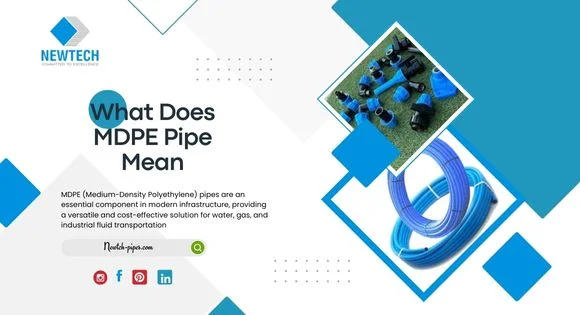What Does MDPE Pipe Mean?
MDPE (Medium-Density Polyethylene) pipes have become an essential part of infrastructure in industries ranging from water supply to gas distribution. Their flexibility, strength, and corrosion resistance make them a preferred choice for many projects. This article explores what MDPE pipes are, their applications, and why they are crucial for modern infrastructure.
Understanding MDPE: What is MDPE Pipe Mean?
Definition of MDPE Pipe
MDPE, or Medium-Density Polyethylene, is a type of thermoplastic produced from ethylene. It falls between high-density polyethylene (HDPE) and low-density polyethylene (LDPE) in terms of density and strength, offering a balance of both flexibility and durability. MDPE pipes are widely used for the transportation of water, gas, and industrial liquids due to their resilience and ease of installation.
Characteristics of MDPE
MDPE pipes are known for several key properties:
- Flexibility: MDPE pipes can bend and adapt to the contours of the ground, reducing the need for fittings.
- Corrosion Resistance: Unlike metal pipes, MDPE does not corrode, making it suitable for underground installations.
- Impact Resistance: MDPE can withstand impacts, making it less prone to breakage during handling or installation.
- Chemical Resistance: MDPE pipes can resist chemicals, making them ideal for industrial applications.
- Cost-Effective: MDPE is less expensive than metals and easier to install, reducing labor costs.
MDPE Pipe Applications
1. Water Supply Systems
MDPE pipes are commonly used in water supply systems because of their resistance to corrosion and chemical reactions. They are ideal for potable water systems as they do not leach harmful substances into the water, ensuring safe drinking water. The flexibility of MDPE makes it easy to install in tight spaces and rugged terrains.
Why MDPE is Ideal for Water Distribution
- Non-toxic and safe for drinking water
- Resistant to both internal and external corrosion
- Lightweight, making it easy to transport and install
2. Gas Distribution Networks
MDPE pipes are frequently used in gas distribution due to their ability to withstand the pressure required for natural gas and other gas transportation. Their durability and flexibility make them a safer and more reliable option than traditional steel pipes, which are prone to corrosion and leaks.
Key Benefits in Gas Networks
- High resistance to crack propagation
- Suitable for underground installations
- Long service life and minimal maintenance
3. Sewage and Drainage Systems
MDPE pipes are also used in sewage and drainage systems. Their corrosion resistance makes them ideal for long-term sewage transport. MDPE’s flexibility ensures that it can adapt to soil movement, which reduces the risk of cracking and failure in drainage systems.
Advantages for Sewage Transport
- Reduced blockages due to smooth internal surfaces
- Resistance to the chemicals often found in sewage
- Ability to handle heavy loads without cracking
4. Industrial and Agricultural Applications
MDPE pipes are used in industrial applications to transport chemicals, slurries, and other industrial fluids. In agriculture, MDPE is commonly used in irrigation systems, offering durability and flexibility to meet the needs of modern farming techniques.
Why MDPE Suits Industrial and Agricultural Use
- Resistant to aggressive chemicals
- Long-lasting, even in extreme temperatures
- Flexible enough to navigate uneven terrains
Benefits of MDPE Pipes
1. Durability and Longevity
MDPE pipes are designed to last for decades, even in challenging environments. Unlike steel or concrete pipes, they are not prone to rusting or cracking, providing a long-term solution for both underground and above-ground installations.
2. Ease of Installation
MDPE is lightweight and flexible, allowing for easier handling during installation. This flexibility reduces the need for joints and fittings, which not only lowers installation costs but also minimizes the chances of leaks and pipe failures over time.
3. Cost-Effective Solution
MDPE pipes are a cost-effective alternative to more expensive materials like copper and steel. Their longevity and minimal maintenance requirements lead to lower overall lifecycle costs.
4. Resistance to Corrosion and Chemicals
MDPE pipes do not corrode when exposed to water or chemicals, unlike metal pipes that can rust or degrade over time. This makes MDPE ideal for use in areas where soil or water conditions may be harsh.
5. Flexibility for Underground Installations
One of the standout features of MDPE is its flexibility. When installed underground, MDPE can bend and adjust to the surrounding environment without cracking or splitting, making it less vulnerable to ground movement.
MDPE Pipe Sizes and Pressure Ratings
Available Sizes
MDPE pipes are available in a wide range of sizes, typically ranging from 20mm to 630mm in diameter. The size chosen depends on the specific application, whether it’s for a small-scale residential water supply or a large-scale industrial project.
Pressure Ratings
MDPE pipes are available in different pressure ratings, generally measured in bar. The most common pressure ratings are:
- 4 bar: Typically used for low-pressure applications like residential water systems.
- 6 bar: Often used for medium-pressure applications.
- 10 bar: Suitable for high-pressure gas and water distribution networks.
How MDPE Pipes Are Manufactured
The Extrusion Process
MDPE pipes are typically manufactured through an extrusion process. Pellets of MDPE are heated and then pushed through a die to create the desired pipe shape. Once formed, the pipe is cooled and cut to the required lengths. This process ensures consistent quality and uniform thickness in the pipes.
Quality Control Measures
During manufacturing, various tests are performed to ensure that the pipes meet industry standards. These tests include checking the pipe’s strength, resistance to chemicals, and pressure-handling capabilities. Manufacturers also inspect the pipes for surface defects and imperfections that could affect performance.
How to Choose the Right MDPE Pipe
1. Consider the Application
The first step in choosing the right MDPE pipe is to consider the application. Different uses require different sizes, pressure ratings, and chemical resistance levels. For example, a water supply system might need a lower pressure rating than a gas distribution network.
2. Evaluate Environmental Conditions
It’s important to consider the environmental conditions where the MDPE pipe will be installed. Factors such as soil acidity, temperature variations, and chemical exposure can affect the pipe’s performance over time.
3. Check Compliance with Standards
MDPE pipes must meet certain regulatory standards, especially when used for gas and water transportation. Ensure that the pipes you select are compliant with national and international standards for safety and quality.
Comparing MDPE to Other Types of Pipes
MDPE vs. HDPE
HDPE (High-Density Polyethylene) pipes are stronger and more rigid than MDPE, making them ideal for high-pressure applications. However, MDPE is more flexible, making it easier to install in areas where the terrain is uneven or where the pipe needs to be bent.
MDPE vs. PVC
PVC (Polyvinyl Chloride) pipes are also used in water and drainage systems. While PVC pipes are more rigid, MDPE offers greater flexibility and impact resistance, particularly in colder climates where PVC can become brittle.
MDPE vs. Steel Pipes
Steel pipes are strong but prone to corrosion and rusting, which can reduce their lifespan. MDPE pipes, on the other hand, are corrosion-resistant and have a much longer service life with less maintenance.
Environmental Impact of MDPE Pipes
MDPE pipes are considered environmentally friendly because they are recyclable and have a lower carbon footprint compared to metal pipes. The production process requires less energy, and the lightweight nature of MDPE reduces transportation emissions. Additionally, MDPE’s long lifespan means fewer replacements, reducing waste over time.
Installation Techniques for MDPE Pipes
1. Trench Installation
MDPE pipes are commonly installed in trenches for water and gas pipelines. The flexible nature of MDPE makes it easy to place in trenches without the need for additional fittings or joints.
2. Trenchless Installation
In certain applications, MDPE pipes can be installed using trenchless techniques, such as directional drilling. This method is less invasive and reduces the environmental impact, particularly in urban areas where traditional trenching may not be possible.
3. Jointing Methods
MDPE pipes can be joined using a variety of techniques, including electrofusion and butt welding. These methods ensure a secure and leak-proof joint, which is essential for gas and water distribution networks.
Conclusion: Why MDPE Pipes Are Essential for Modern Infrastructure
MDPE pipes provide a durable, flexible, and cost-effective solution for transporting water, gas, and industrial fluids. Their resistance to corrosion, ease of installation, and long service life make them an ideal choice for both residential and commercial projects. Understanding what MDPE pipes mean and how they perform in various applications can help businesses and homeowners make informed decisions when choosing the right materials for their infrastructure projects.
MDPE pipes continue to play a vital role in global infrastructure, helping to deliver clean water, distribute gas safely, and support various industrial processes. By offering a combination of strength, flexibility, and affordability, MDPE pipes are likely to remain a preferred choice for many years to come.
FAQs on MDPE Pipes
Q1: What does MDPE stand for?
A: MDPE stands for Medium-Density Polyethylene, a type of thermoplastic known for its strength and flexibility.
Q2: What are MDPE pipes used for?
A: MDPE pipes are mainly used for water supply, gas distribution, sewage systems, and various industrial applications.
Q3: How long do MDPE pipes last?
A: MDPE pipes can last up to 50 years or more, depending on installation quality and environmental factors.
Q4: Are MDPE pipes resistant to chemicals?
A: Yes, MDPE pipes are highly resistant to a range of chemicals, making them suitable for industrial use.
Q5: How do MDPE pipes compare to HDPE pipes?
A: MDPE pipes are more flexible than HDPE pipes but have a lower pressure rating. Both offer excellent durability and corrosion resistance.
Q6: Can MDPE pipes be used for drinking water?
A: Yes, MDPE pipes are safe for transporting potable water and are non-toxic.
Q7: How are MDPE pipes installed?
A: MDPE pipes can be installed through trenching or trenchless methods, with joints fused using techniques like electrofusion or butt welding.
Q8: Are MDPE pipes environmentally friendly?
A: MDPE pipes are recyclable and have a lower carbon footprint compared to metal pipes, making them a more sustainable option.


